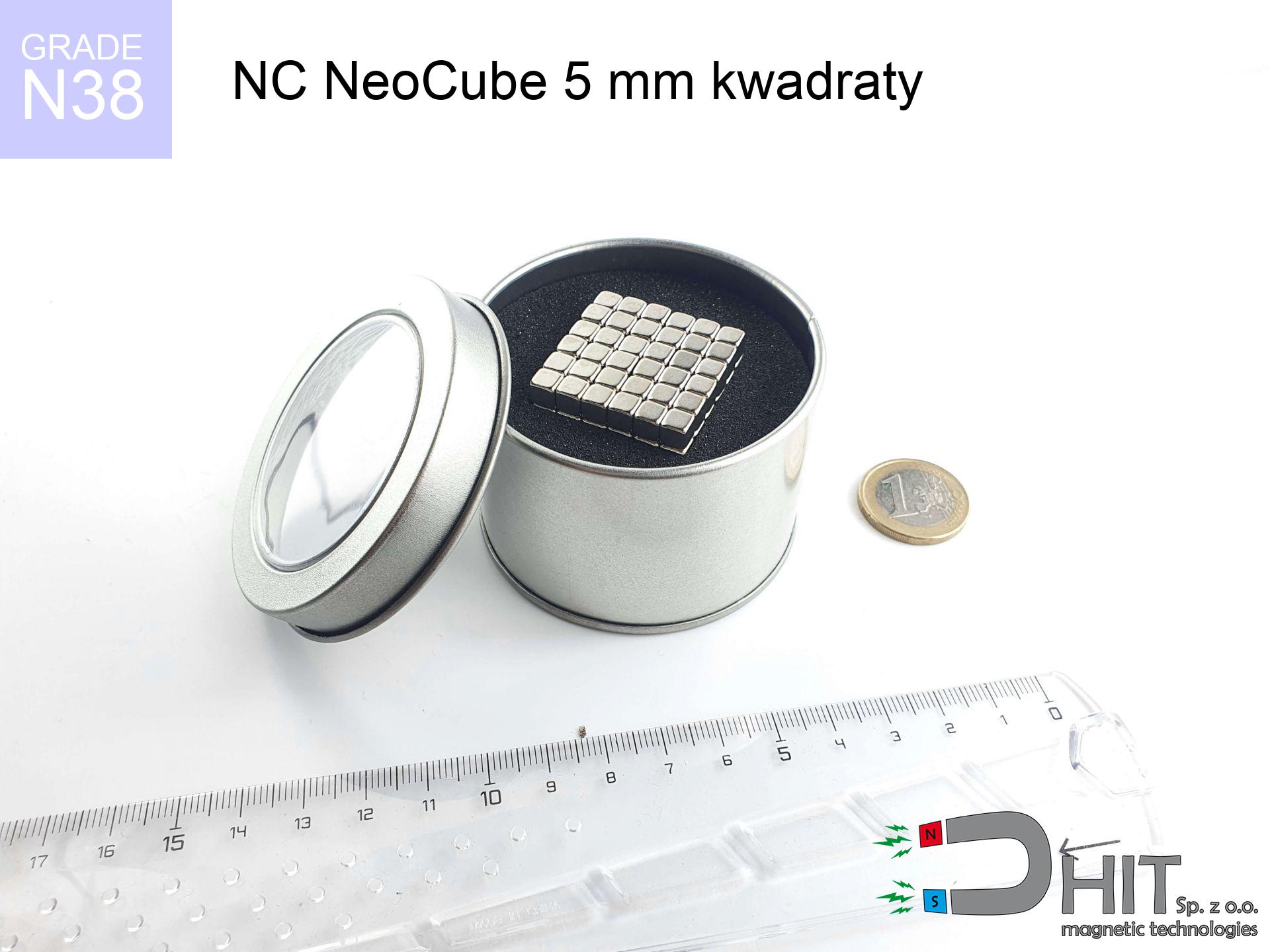NC NeoCube 5 mm kwadraty / N38 - neocube
neocube
Catalog no 120227
GTIN: 5906301812661
Weight
216.5 g
Magnetization Direction
↑ axial
Coating
[NiCuNi] nickel
49.99 ZŁ with VAT / pcs + price for transport
40.64 ZŁ net + 23% VAT / pcs
bulk discounts:
Need more?Need help making a decision?
Call us
+48 22 499 98 98
if you prefer let us know using
request form
the contact form page.
Specifications along with shape of neodymium magnets can be tested on our
our magnetic calculator.
Orders placed before 14:00 will be shipped the same business day.
NC NeoCube 5 mm kwadraty / N38 - neocube
Magnetic properties of material N38
Physical properties of NdFeB
Shopping tips
Advantages and disadvantages of neodymium magnets NdFeB.
Besides their stability, neodymium magnets are valued for these benefits:
- They virtually do not lose power, because even after 10 years, the performance loss is only ~1% (based on calculations),
- They remain magnetized despite exposure to magnetic surroundings,
- Thanks to the glossy finish and silver coating, they have an visually attractive appearance,
- They have exceptional magnetic induction on the surface of the magnet,
- They are suitable for high-temperature applications, operating effectively at 230°C+ due to advanced heat resistance and form-specific properties,
- With the option for tailored forming and precise design, these magnets can be produced in multiple shapes and sizes, greatly improving design adaptation,
- Important function in modern technologies – they are used in hard drives, electromechanical systems, medical equipment or even high-tech tools,
- Compactness – despite their small size, they deliver powerful magnetism, making them ideal for precision applications
Disadvantages of rare earth magnets:
- They are prone to breaking when subjected to a sudden impact. If the magnets are exposed to mechanical hits, we recommend in a protective case. The steel housing, in the form of a holder, protects the magnet from fracture and reinforces its overall strength,
- High temperatures may significantly reduce the field efficiency of neodymium magnets. Typically, above 80°C, they experience permanent decline in performance (depending on size). To prevent this, we offer heat-resistant magnets marked [AH], capable of working up to 230°C, which makes them perfect for high-temperature use,
- Due to corrosion risk in humid conditions, it is wise to use sealed magnets made of protective material for outdoor use,
- The use of a protective casing or external holder is recommended, since machining internal cuts in neodymium magnets is difficult,
- Safety concern linked to microscopic shards may arise, in case of ingestion, which is important in the context of child safety. Additionally, miniature parts from these devices have the potential to disrupt scanning if inside the body,
- In cases of mass production, neodymium magnet cost is a challenge,
Precautions
Neodymium magnets are the most powerful magnets ever invented. Their power can surprise you.
Make sure to review all the information we have provided. This will help you avoid harm to your body and damage to the magnets.
Make sure not to bring neodymium magnets close to the TV, wallet, and computer HDD.
Neodymium magnets produce strong magnetic fields that can damage magnetic media such as floppy disks, video tapes, HDDs, credit cards, magnetic ID cards, cassette tapes, or other devices. They can also damage videos, televisions, CRT computer monitors. Remember not to place neodymium magnets close to these electronic devices.
Neodymium magnets are not recommended for people with pacemakers.
Neodymium magnets produce strong magnetic fields that can interfere with the operation of a heart pacemaker. However, if the magnetic field does not affect the device, it can damage its components or deactivate the device when it is in a magnetic field.
Neodymium magnets can demagnetize at high temperatures.
Although magnets have demonstrated their effectiveness up to 80°C or 175°F, the temperature can vary depending on the type, shape, and intended use of the specific magnet.
Dust and powder from neodymium magnets are flammable.
Avoid drilling or mechanical processing of neodymium magnets. If the magnet is crushed into fine powder or dust, it becomes highly flammable.
It is crucial not to allow the magnets to pinch together uncontrollably or place your fingers in their path as they attract to each other.
Neodymium magnets bounce and clash mutually within a radius of several to around 10 cm from each other.
Never bring neodymium magnets close to a phone and GPS.
Neodymium magnets produce intense magnetic fields that interfere with magnetometers and compasses used in navigation, as well as internal compasses of smartphones and GPS devices.
Magnets are not toys, youngest should not play with them.
Not all neodymium magnets are toys, so do not let children play with them. In the case of small magnets, they can be swallowed and cause choking. In such cases, the only solution is to undergo surgery to remove the magnets, and otherwise, it can even lead to death.
Neodymium magnets are especially delicate, which leads to damage.
Magnets made of neodymium are highly delicate, and by joining them in an uncontrolled manner, they will crumble. Neodymium magnetic are made of metal and coated with a shiny nickel, but they are not as durable as steel. In the event of a collision between two magnets, there may be a scattering of fragments in different directions. Protecting your eyes is crucial in such a situation.
The magnet coating is made of nickel, so be cautious if you have an allergy.
Studies clearly indicate a small percentage of people who suffer from metal allergies such as nickel. An allergic reaction often manifests as skin redness and rash. If you have a nickel allergy, try wearing gloves or avoid direct contact with nickel-plated neodymium magnets.
Pay attention!
In order for you to know how powerful neodymium magnets are and why they are so dangerous, read the article - Dangerous powerful neodymium magnets.





![SM 32x150 [2xM8] / N52 - magnetic separator SM 32x150 [2xM8] / N52 - magnetic separator](https://cdn3.dhit.pl/graphics/products/sm-32x150-2xm8-xuc.jpg)


